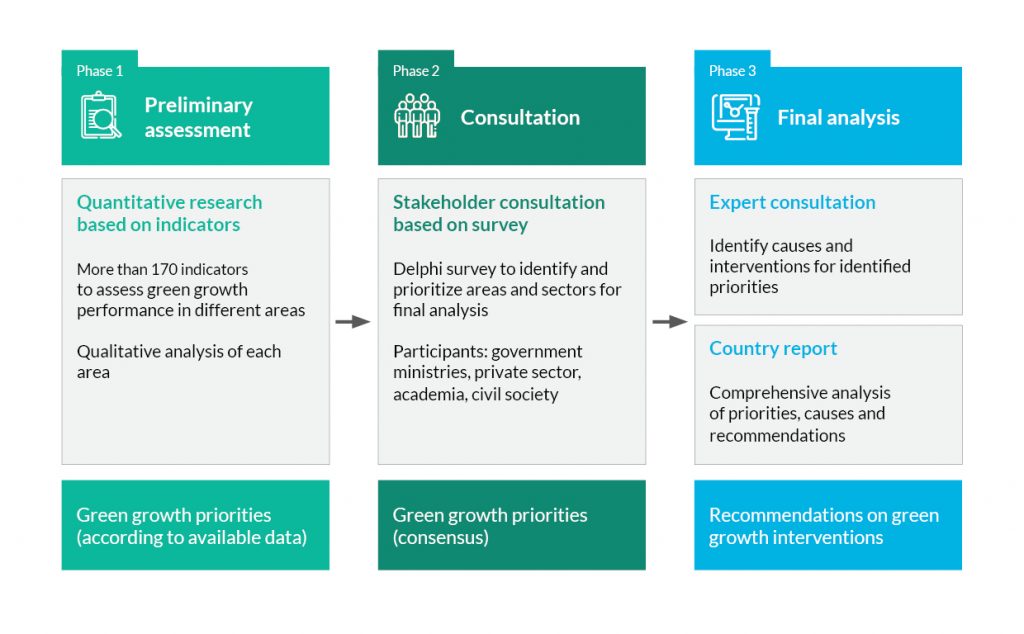GGGI published a report explaining the revised methodology behind the organization’s country assessments—the so-called Green Growth Potential Assessments (GGPA). The GGPA is a diagnostic tool, consisting of a combination of data analysis and stakeholder consultation in order to identify and prioritize a country’s opportunities for green growth. The report provides a detailed overview of the assessment methodology in its current form and the extensive changes made to it since the first GGPA was conducted in 2015.
Figure 1. Conceptual schematic of the GGPA process

Source: Global Green Growth Institute
GGGI defines green growth as a development approach that seeks to deliver economic growth that is both environmentally sustainable and socially inclusive. Through the green growth model, countries seek opportunities for economic growth that are low-carbon and climate resilient, prevent or remediate pollution, and maintain healthy and productive ecosystems as well as create green jobs, reduce poverty, and enhance social inclusion. While the awareness of and commitment to green growth are rising worldwide, green growth is a broad concept, encompassing not only different economic sectors but also different levels of intervention. Furthermore, what green growth means in individual countries and how it can be translated into specific actions depend on a wide range of factors, such as a given economy’s stage of development, its endowment with natural assets, and its social characteristics. Therefore, there is a need to clarify what green growth means in a specific country’s context, identify priorities, and assess those priorities systematically. For that purpose, GGGI developed the Green Growth Potential Assessment.
During the past four years, GGPAs have been successfully concluded in nine countries: Cambodia, Colombia, the Lao PDR, Mozambique, Myanmar, Nepal, Papua New Guinea, Peru, and Qatar. While the past four years have demonstrated the GGPA’s usefulness, experiences made during that period have also triggered a wide range of revisions to the initial assessment process. These changes encompass all three stages of the assessment process: the preliminary assessment, consultation process, and final analysis.
Figure 2. Overview of the GGPA process

Source: Global Green Growth Institute
Two major adjustments have been made to the preliminary assessment. First, the analytical framework has been extended to cover the dimension of social inclusion. Second, the set of indicators has been considerably extended from a selection of 48 individual indicators to more than 170 indicators, allowing for a more granular assessment.
The consultation process was subject to two major adjustments. First, the application of the Delphi survey technique has been refined, including the number of survey rounds, combination of presenting the results of the preliminary assessment and gathering participants’ feedback, and design of the group discussions. Second, the results of the consultation are summarized in a workshop report. Such a report provides workshop participants with a final opportunity to comment on and voice disagreement with the results of the consultation and thereby determine the scope and direction of the final analysis. In addition, the workshop report allows external audiences to understand the process and the results of the workshop.
Several major revisions were also made to the final analysis, such as the way its recommendations are developed, the format in which they are presented, and the scope that these recommendations address. First, Under the revised method, recommendations are developed based on analysis drawn from (1) existing research; (2) gaps in existing policies, plans, strategies, and regulation; and (3) a series of expert interviews conducted in the assessment country. Second, the format to present those recommendations has also evolved, strengthening the link between the recommendations and the underlying analysis. Under the revised methodology, the final report is explicitly designed around a set of recommendations. Each recommendation is introduced upfront in its own section, followed by the related analysis outlining its relevance and providing evidence for its effectiveness. The analysis generally aims to demonstrate why and how a specific recommendation can bring about a desired result. Third, the scope of recommendations varies, depending on the purpose for which a government or GGGI itself wants an assessment to be conducted. This is a major change from the initial setup of the final analysis, with its exclusive focus on policy options. Finally, an approach to conduct a more rapid assessment has been developed, which can be applied in countries where a full-fledged GGPA is not needed.
Download full report here.